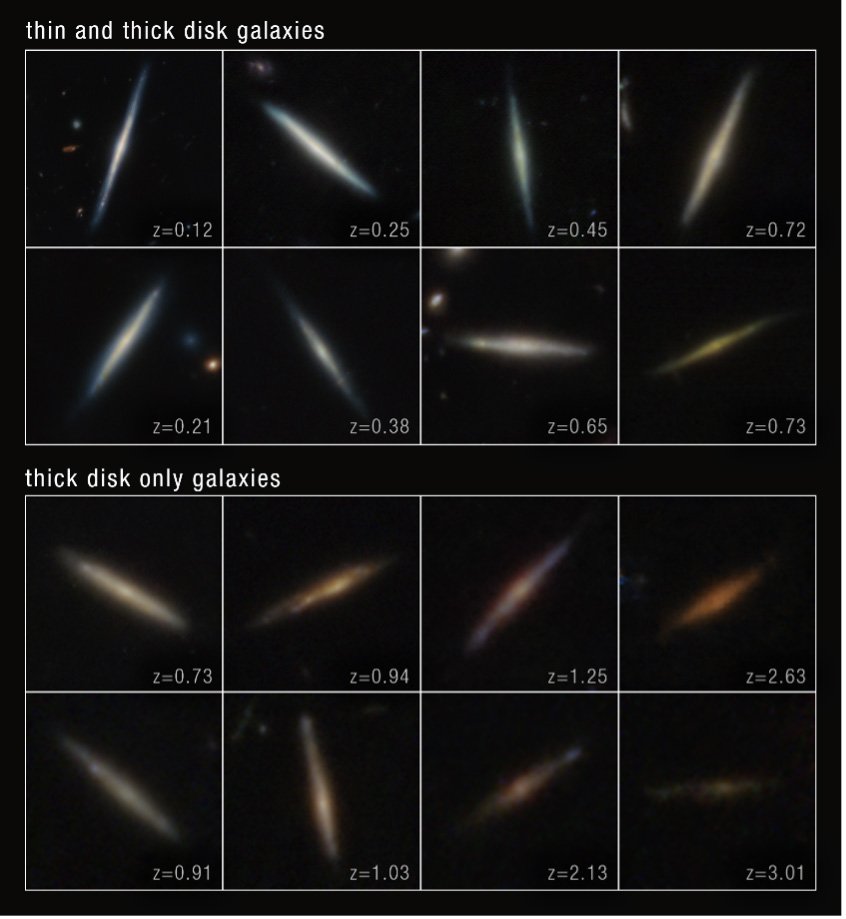Many galaxies, including our own Milky Way, are characterized by a flat, extended, rotating stellar disk. These disk galaxies commonly contain two main parts: a thin disk and a thick disk. The thin disk contains younger, metal-rich stars, while the thick disk contains older, metal-poor stars. These distinct components hold fossil records that help astronomers understand how galaxies form stars, build up elements like oxygen and carbon, essential for life, and evolve into their present shapes.
Until now, thin and thick disks have only been identified in the Milky Way and nearby galaxies. It has been impossible with previous telescopes to distinguish the thin edge of a distant galaxy when viewed from the side.
That changed with the launching of the James Webb Space Telescope (JWST) in 2021, which is currently the largest telescope in space.
An international team of researchers has examined 111 JWST images of distant edge-on galaxies, ones where the alignments enabled the researchers to observe the galaxies' vertical disk structures.
Takafumi Tsukui (formerly of the Australian National University and now based at Tohoku University), who led the research team, says that observing distant galaxies is like using a time machine, allowing us to see how galaxies have built their disks over cosmic history.
"Thanks to the JWST's sharp vision, we were able to identify thin and thick disks in galaxies beyond our local universe, some going as far back as 10 billion years ago."
The study revealed a consistent trend: in the earlier universe, more galaxies appear to have had a single thick disk, while in later epochs, more galaxies showed a two-layered structure with an additional thin disk component. This suggests that galaxies first formed a thick disk, followed by the formation of a thin disk within it. In more massive galaxies, this thin disk appears to have formed earlier.
The study estimated the thin disk formation time for Milky Way-sized galaxies to be around 8 billion years ago. This figure aligns with formation timelines for the Milky Way itself, where stellar ages can be measured.
To understand the revealed sequential formation from thick to thin disks and the corresponding formation timelines, the team not only examined the stellar structure but also the motion of gas, direct ingredients of stars obtained from the Atacama Large Millimeter/submillimeter Array (ALMA) and ground-based surveys in the literature. These observations supported a coherent formation scenario:
- In the early universe, galactic disks are rich in gas and highly turbulent
- Intense star formation in the turbulent disks gives rise to thick stellar disks
- As stellar disks develop, they help stabilize the gas disks and reduce the turbulence
- As the disk calms, a thin stellar disk forms inside the pre-developed thick stellar disks
- Whereas larger galaxies can efficiently convert gas into stars, forming thin disks earlier

Tsukui emphasizes that the images provided by JWST help answer one of the biggest questions in astronomy: was our galaxy's formation typical or unique? "The JWST images provided a window into galaxies that resemble the Milky Way's early state, bringing us valuable insights from galaxies far away."
The team hopes that their study will help bridge studies of nearby galaxies with far away ones and refine our understanding of disk formation. The study was published in the journal Monthly Notices of the Royal Astronomical Society on June 26, 2025.
- Publication Details:
Title: The emergence of galactic thin and thick discs across cosmic history
Authors: Takafumi Tsukui, Emily Wisnioski, Joss Bland-Hawthorn, Ken Freeman
Journal: Monthly Notices of the Royal Astronomical Society






